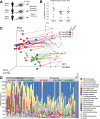Gut microbiota from high-risk men who have sex with men drive immune activation in gnotobiotic mice and in vitro HIV infection
- PMID: 30947289
- PMCID: PMC6448819
- DOI: 10.1371/journal.ppat.1007611
Gut microbiota from high-risk men who have sex with men drive immune activation in gnotobiotic mice and in vitro HIV infection
Abstract
Men who have sex with men (MSM) have differences in immune activation and gut microbiome composition compared with men who have sex with women (MSW), even in the absence of HIV infection. Gut microbiome differences associated with HIV itself when controlling for MSM, as assessed by 16S rRNA sequencing, are relatively subtle. Understanding whether gut microbiome composition impacts immune activation in HIV-negative and HIV-positive MSM has important implications since immune activation has been associated with HIV acquisition risk and disease progression. To investigate the effects of MSM and HIV-associated gut microbiota on immune activation, we transplanted feces from HIV-negative MSW, HIV-negative MSM, and HIV-positive untreated MSM to gnotobiotic mice. Following transplant, 16S rRNA gene sequencing determined that the microbiomes of MSM and MSW maintained distinct compositions in mice and that specific microbial differences between MSM and MSW were replicated. Immunologically, HIV-negative MSM donors had higher frequencies of blood CD38+ HLADR+ and CD103+ T cells and their fecal recipients had higher frequencies of gut CD69+ and CD103+ T cells, compared with HIV-negative MSW donors and recipients, respectively. Significant microbiome differences were not detected between HIV-negative and HIV-positive MSM in this small donor cohort, and immune differences between their recipients were trending but not statistically significant. A larger donor cohort may therefore be needed to detect immune-modulating microbes associated with HIV. To investigate whether our findings in mice could have implications for HIV replication, we infected primary human lamina propria cells stimulated with isolated fecal microbiota, and found that microbiota from MSM stimulated higher frequencies of HIV-infected cells than microbiota from MSW. Finally, we identified several microbes that correlated with immune readouts in both fecal recipients and donors, and with in vitro HIV infection, which suggests a role for gut microbiota in immune activation and potentially HIV acquisition in MSM.
Conflict of interest statement
The authors have declared that no competing interests exist.
Figures






References
-
- CDC. HIV and Gay and Bisexual Men: Centers for Disease Control and Prevention; 2018 [updated September 26, 2018]. Available from: https://www.cdc.gov/hiv/group/msm/index.html.
Publication types
MeSH terms
Substances
Grants and funding
LinkOut - more resources
Full Text Sources
Medical
Molecular Biology Databases
Research Materials

